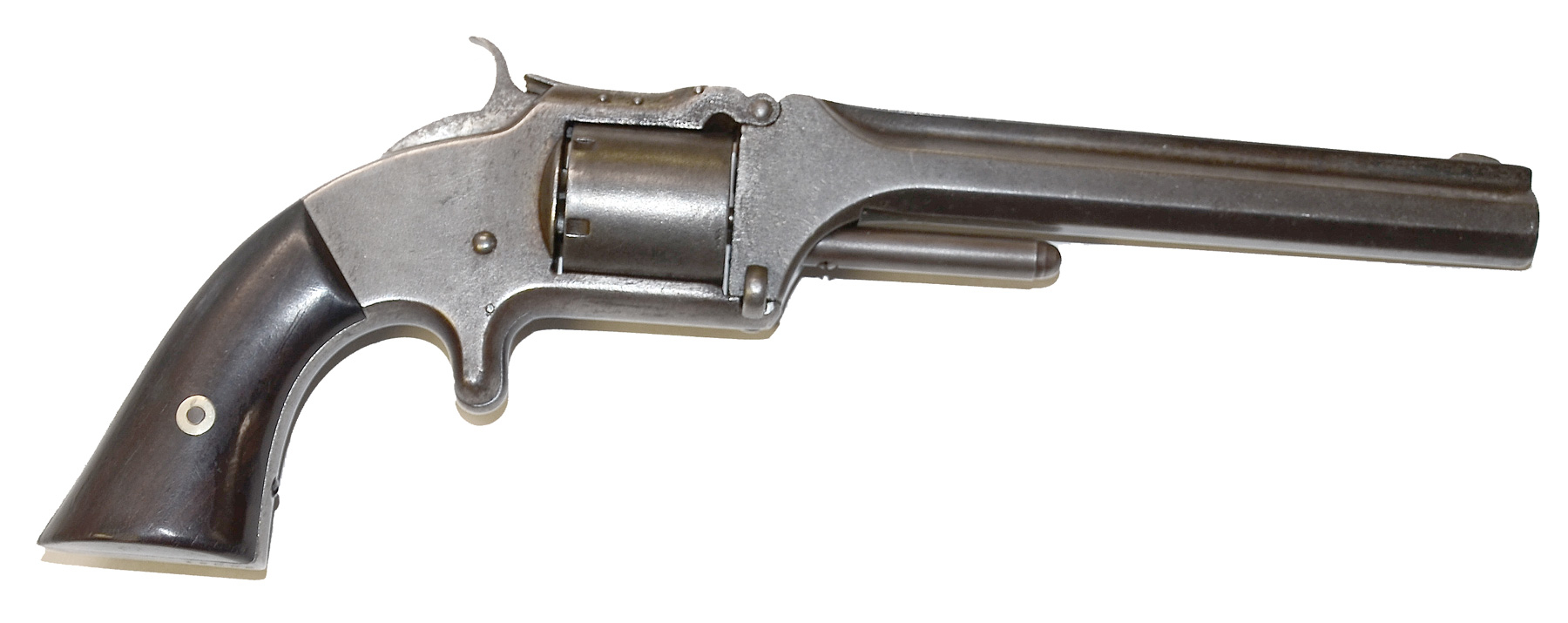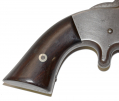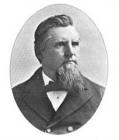site search
online catalog
INSCRIBED SMITH AND WESSON OF LIEUTENANT JOHN LONSDALE ROPER, 11th PA CAVALRY, LED ADVANCED TROOPS, CONDUCTED CHARGES, CITED IN OFFICIAL RECORDS, CO-AUTHOR REGIMENTAL HISTORY

$2,750.00 SOLD
Quantity Available: None
Item Code: 600-11
This Smith and Wesson Number Two Army revolver is serial numbered 19032, made early in the war (numbers reached 35,000 by war’s end) and bears a professionally engraved inscription on the backstrap: “Lieut. J.L. Roper 11th Penna Cavalry.” The pistol rates very good or better for condition, with 30 percent or more thin blue remaining, with thicker coverage on the barrel and thinning toward the rear where it mixes with gray from handling, though the screwheads show good blue. The metal is generally smooth, showing just some light pitting on the top of the frame, near the hinge, and at the edge of the frame in front of the cylinder, which is pretty common from firing. The rosewood grips are excellent, with nice color and surface. The markings are sharp. The mechanics are good.
A cursory check of Roper’s service record is deceiving. He enlisted and mustered into Co. L of the 11th PA Cavalry as a sergeant on 9/25/61 and made 2nd lieutenant in Co. I on 10/12/62. On 1/20/63, however, he is listed as becoming 1st lieutenant and commissary, which would seem to take him out of the fighting, and was followed up by a promotion to captain and commissary in the volunteer forces, which made him part of the general staff. He then served until resigning 2/5/65.
Roper, in fact, has something of a fighting record and when he was breveted to major (3/13/1865) it was for, “for gallant and meritorious conduct in many engagements.” The regiment had been split up for service in mid-1862, but was reunited in August at Suffolk, Va., on the south side of the James River, from which point it was continually engaged in picketing, scouting, and expeditions into southeastern Virginia and adjacent areas of North Carolina, until it joined the Army of the James in May 1864, when it took part in the fighting around Richmond and Petersburg. CivilWardata lists 96 points at which they suffered casualties, which amounted to 11 officers and 108 enlisted men killed or mortally wounded, a significant toll for a cavalry unit.
Roper seems to have had a special aptitude for leading the advance guard on expeditions undertaken by the regiment. On December 2, 1862, they were pushing west from Suffolk when a Confederate force was reported moving toward them from the town of Franklin and a battalion was sent forward. Roper had command of the advance guard, “which was made up of a detail from the several companies of the regiment, and upon meeting the enemy was some distance in advance of the command under Major Stratton. Lieutenant Roper, upon coming in sight of the Confederate column, ordered and led the charge, and was nobly supported by the gallant little force under his command….” The battalion came up and joined the fight, routing the enemy and in the process recapturing a rocket battery that had been captured from McClellan on the peninsula.
Roper’s aggressiveness must have impressed his superiors for we find him performing the same duty several more times. In the official report of January 1863 expedition, he is by regimental commander S.P. Spear, himself an aggressive leader, for “his prompt, energetic, and faithful performance of the important duty of leading the advance of such a large body of troops.” And, a little less than three weeks later, at Deserted House (Jan. 28,) he seems to have been at it again. Assigned by Gen. Corcoran to lead the advance party in another expedition, he charged a
Confederate picket post along a woodline near Carrsville, driving them back into the woods, and followed it up with a charge against the picket reserve, which was unexpectedly large, but overshot their targets: “Lieutenant Roper’s charges upon the enemy’s pickets were executed with creditable dash,” in the words of the regimental history. (The expedition as a whole, however, was less successful: Roper thought Corcoran flubbed it by not immediately following up the initial success.
Roper’s posting as regimental commissary may not have taken effect before the fight at Deserted House, but we find him again leading an attack as late as June 26, during a raid to destroy a railroad bridge over the North Anna River as part of Dix’s 1863 peninsular campaign. When a stubborn Confederate blockhouse stood in the way, Roper led his advance party across the river to join in an attack on it from the rear, netting some 125 prisoners after some stiff fighting. Two companies had been ordered to ford the river some distance away. Roper, “crossed the river at a shorter distance below the bridge, dismounted his men under cover of a thick growth of bust, proceeded on foot, charged and captured this guard after a hand-to-hand conflict. Capt. Skelly [with the two companies that crossed farther away] came up in time to take part. The Confederates made a gallant resistance, but were not able to withstand the attack, and therefore surrendered.” (As a side note, this raid also bagged Gen. W.H.F. Lee, R.E. Lee’s son, who was recuperating from a wound nearby.)
Roper was certainly well-liked by Col. Spear, who had been given command of the brigade in July. In August 1863 Roper was applying for promotion to captain in the Commissary Department and Spear provided a glowing recommendation, indicating he wished to have Roper on his brigade staff as commissary. In the end, Roper was promoted to captain and commissary as of 4/20/64, but was ended up being snagged as division commissary by Gen. Kautz, with whom he served until February 1865, about the time Kautz move from command of the cavalry division of the Army of the James, to command of a division of the 25th Corps. Roper’s actions in the field under Kautz are less well documented, but an experienced commissary officer would have been essential for Kautz, whose cavalry was involved in a number of raids and expeditions in support of Grant’s campaign against Petersburg and Richmond.
Neither Ropes’ independence on the battlefield, his administrative abilities, or perhaps his ability to forage for necessary supplies are a surprise. Born in 1835, he was compelled to work at age eight by his father’s early death, found employment at age 13 as a store clerk and worked his way up to bookkeeper (and some say manager,) though largely self-educated. He went to California in 1857 to try his luck in the mines, and returned home in 1861 with at least enough money to buy $3,5000 in government bonds before enlisting. After the war he capitalized on his wartime knowledge of southeastern Virginia and nearby North Carolina to move to Norfolk and establish the Roper Lumber Company, which was immensely profitable to him and to the local economy, and enabled him to expand his business interests to railroading, banking and insurance. The town of Lee’s Mills, NC, even renamed itself “Roper” in the 1880s. He died in 1921, respected not just for his business acumen, but for his charitable causes as well. Perhaps he was making up for some burned bridges. [sr] [ph:L]
DISCLAIMER: All firearms are sold as collector's items only - we do not accept responsibility as to the shooting safety or reliability of any antique firearm. All firearms are described as accurately as possible, given the restraints of a catalog listing length. We want satisfied customers & often "under" describe the weapons. Any city or state regulations regarding owning antique firearms are the responsibility of the purchaser. All firearms are "mechanically perfect" unless noted, but again, are NOT warranted as safe to fire!
~~~~~~~~~~~~~~~~~~~~~~~~~~~~~~~~~~~
THIS ITEM, AS WITH ALL OTHER ITEMS AVAILABLE ON OUR WEB SITE,
MAY BE PURCHASED THROUGH OUR LAYAWAY PROGRAM.
FOR OUR POLICIES AND TERMS,
CLICK ON ‘CONTACT US’ AT THE TOP OF ANY PAGE ON THE SITE,
THEN ON ‘LAYAWAY POLICY’.
THANK YOU!
Inquire About INSCRIBED SMITH AND WESSON OF LIEUTENANT JOHN LONSDALE ROPER, 11th PA CAVALRY, LED ADVANCED TROOPS, CONDUCTED CHARGES, CITED IN OFFICIAL RECORDS, CO-AUTHOR REGIMENTAL HISTORY
For inquiries, please email us at [email protected]
Most Popular
Historical Firearms Stolen From The National Civil War Museum In Harrisburg, Pa »
Theft From Gravesite Of Gen. John Reynolds »
Cavalry Carbine Sling Swivel »
Fine Condition Brass Infantry Bugle Insignia »
featured item
VERY RARE US MODEL 1840 AMES CAVALRY OFFICER’S SWORD WITH QUILLBACK SOLINGEN BLADE
Very rare Ames with gold washed, quillback, Damascus blade from Solingen. Manufactured: Springfield, MA / Solingen Maker: N.P.Ames Year: C1840s Model: M1840 Size: 33 5/8 inch blade length, 1.18 wide Condition: Excellent+ This is obviously a product… (870-238). Learn More »














